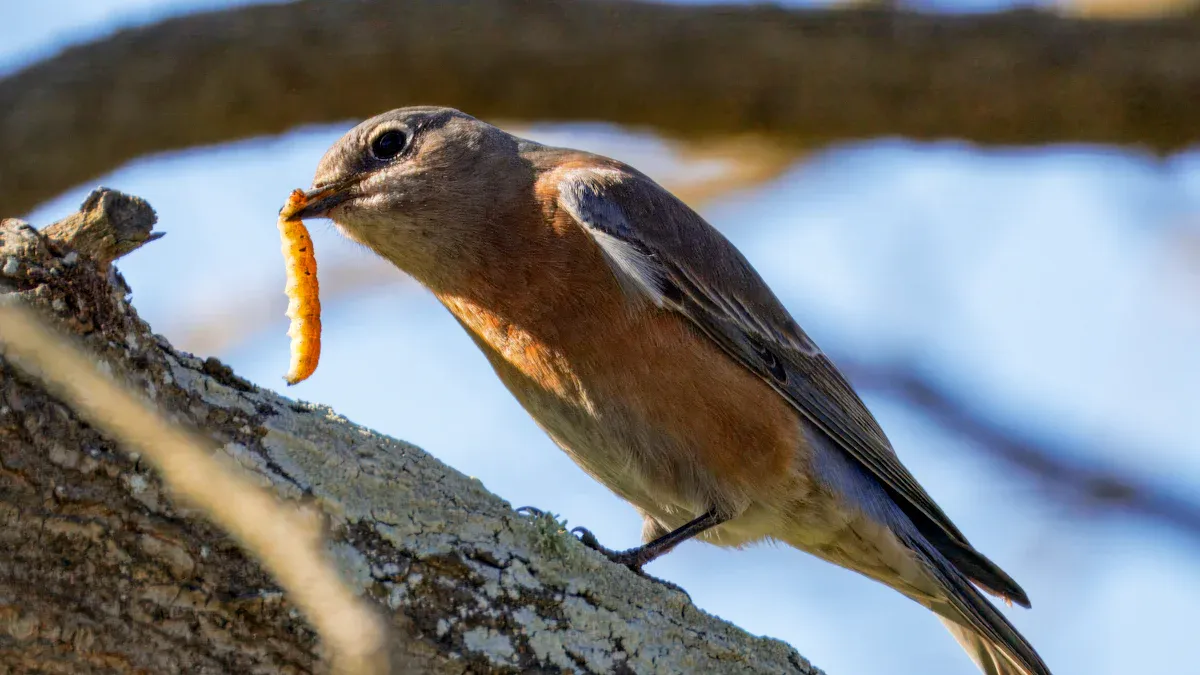
Dried mealworms offer birds a feast they can’t resist. Packed with protein, fats, and nutrients, they fuel birds with energy for their daily activities. These tasty morsels mimic what birds eat in the wild, making them a natural choice. With bird feed mealworms, feeders can support birds’ health all year round while enjoying their visits.
Key Takeaways
- Dried mealworms are full of protein and good fats. They are a great food for birds, especially during nesting or migration times.
- You can offer mealworms in feeders or mix them with seeds. This helps attract more bird types and makes feeding more fun for them.
- Storing mealworms the right way keeps them fresh and healthy. This lets you feed birds all year without them going bad.
Nutritional Benefits of Bird Feed Mealworms
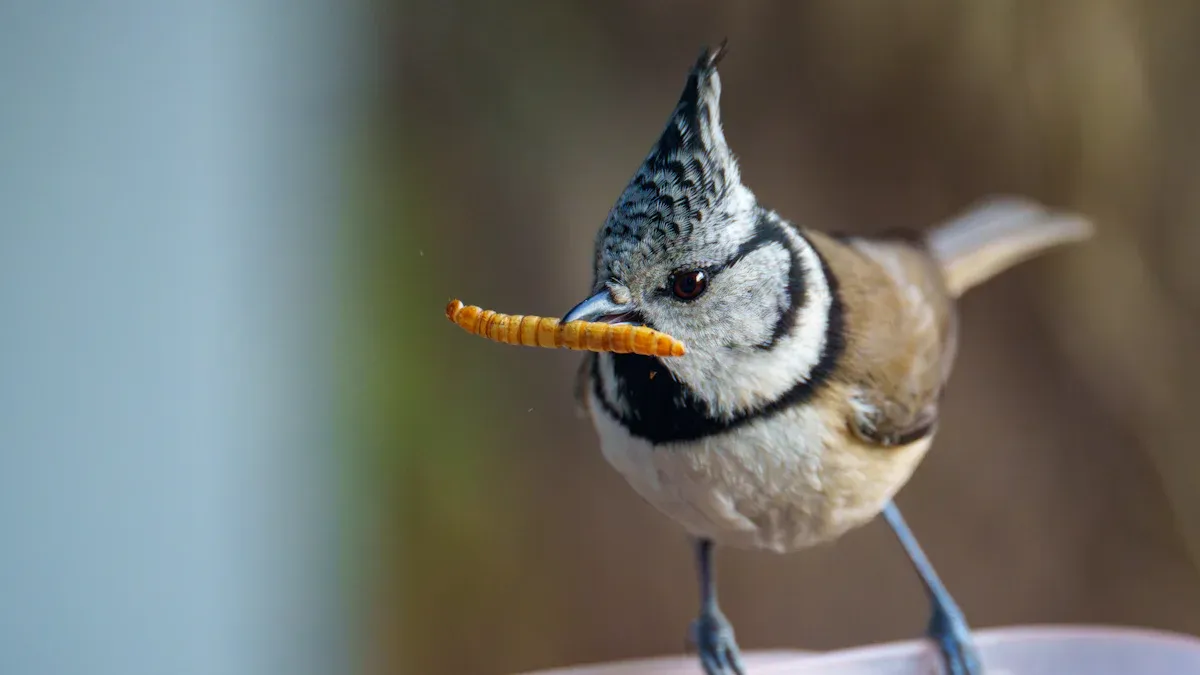
High Protein Content for Energy and Growth
Protein plays a vital role in a bird’s life. It helps them grow strong muscles, repair tissues, and stay active throughout the day. Mealworms are packed with protein, making them an excellent choice for birds that need extra energy. Whether it’s a chick growing in the nest or an adult bird preparing for migration, protein-rich bird feed mealworms provide the boost they need. Birds love the taste, and feeders love how easy it is to offer them a nutritious snack.
Rich in Fats for Feather Health and Warmth
Fats are essential for birds, especially during colder months or long migrations. Mealworms contain healthy fats that support feather health and help birds stay warm. Feathers need proper care to remain strong and waterproof, and fats play a big role in this process.
Studies show that birds selectively store certain long-chain unsaturated fatty acids, which improve energy metabolism and support cell membrane functions. For example, starlings rely on fatty acids like 18:1 and 18:2 during migration to maintain their energy levels. Here’s a closer look at the relationship between dietary fats and bird health:
| Evidence Description | Impact on Birds |
|---|---|
| Fatty acid concentration was directly measured by gas chromatography in lipids extracted from the diets and the furcular fat. | Indicates the direct relationship between dietary fats and bird fat stores. |
| Differences in fatty acid composition of fat stores in starlings, specifically the relative amounts of 18:1, 18:2, and 18:3, are among the primary longer chain fatty acids that compose the fat stores of wild songbirds especially during migration. | Suggests that specific fatty acids are crucial for energy storage during migration. |
| Selectively eating and hence storing certain long-chain unsaturated fatty acids may be advantageous because such fatty acids may affect composition and key functions of lipid-rich cell membranes, may be metabolized more quickly, or may stimulate key facets of aerobic metabolism. | Highlights the potential benefits of these fats for energy metabolism and overall bird health. |
Mealworms offer these essential fats in a convenient form, making them a favorite among bird enthusiasts.
Essential Vitamins and Minerals for Overall Well-being
Birds need more than just protein and fats to thrive. Vitamins and minerals are key to their overall health. Mealworms are rich in nutrients like potassium, magnesium, and iron, which support strong bones, healthy blood flow, and proper nerve function. These nutrients also help birds fight off illnesses and recover quickly from injuries.
Feeding birds with bird feed mealworms ensures they get a balanced diet that mimics their natural food sources. This makes mealworms a reliable option for year-round feeding, whether it’s during nesting season or the colder months.
Bird Species That Love Bird Feed Mealworms
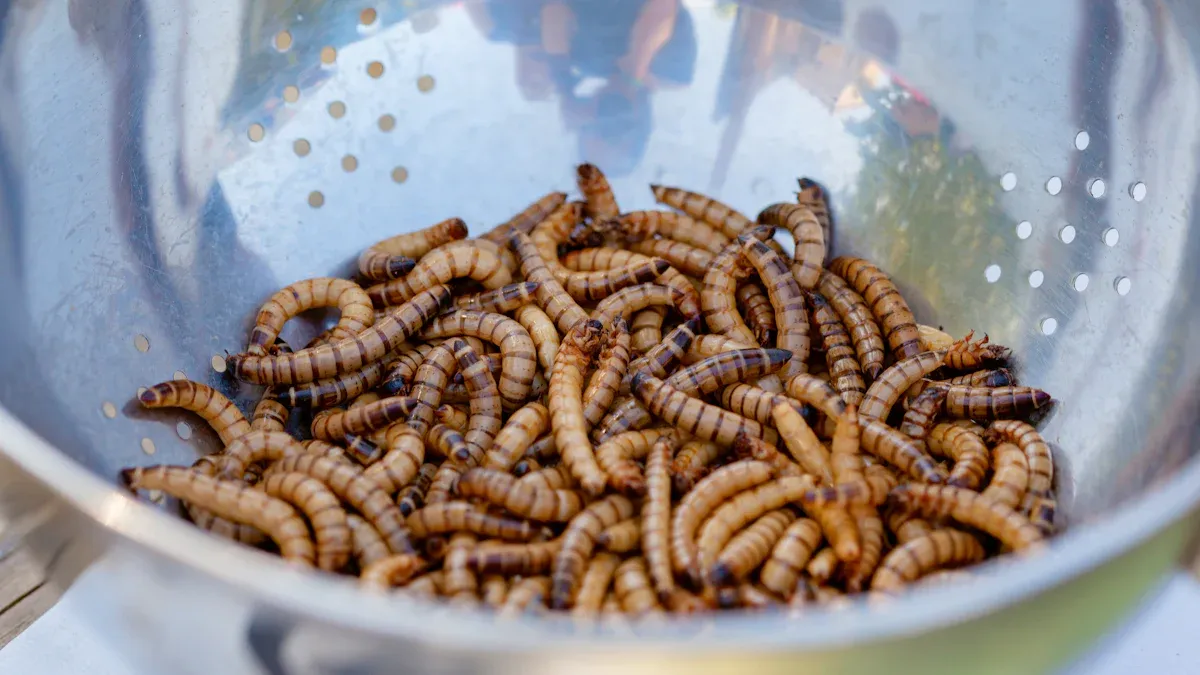
Common Backyard Birds That Enjoy Mealworms
Mealworms are a favorite treat for many backyard birds. These protein-packed snacks attract a variety of species, making them a must-have for bird enthusiasts. Some of the most common visitors include:
- Bluebirds, who love mealworms as a substitute for insects during winter.
- Robins, known for their preference for protein-rich foods.
- Chickadees, who eagerly snack on mealworms when seeds are scarce.
- Wrens and nuthatches, who enjoy the convenience of mealworms in feeders.
Interestingly, while most feeder birds adore mealworms, goldfinches tend to skip this treat. Offering mealworms in your backyard can create a lively scene as birds flock to enjoy this nutritious snack.
Seasonal Birds and Their Nutritional Needs
Birds’ diets change with the seasons, and mealworms play a vital role in meeting their nutritional needs. During spring and summer, insects dominate their diet, providing essential protein for growth and reproduction. In winter, fruits and seeds become more common, but mealworms can supplement these foods to ensure a balanced diet.
Here’s a comparison of the nutritional content of live and dried mealworms, highlighting their value across seasons:
| Type of Mealworm | Moisture | Lipid (Fat) | Protein | Ash | Carbohydrate |
|---|---|---|---|---|---|
| Live Mealworms | 62% | 13% | 20% | 1.5% | 3.1% |
| Dried Mealworms | 5% | 28% | 53% | 4.1% | 8.5% |
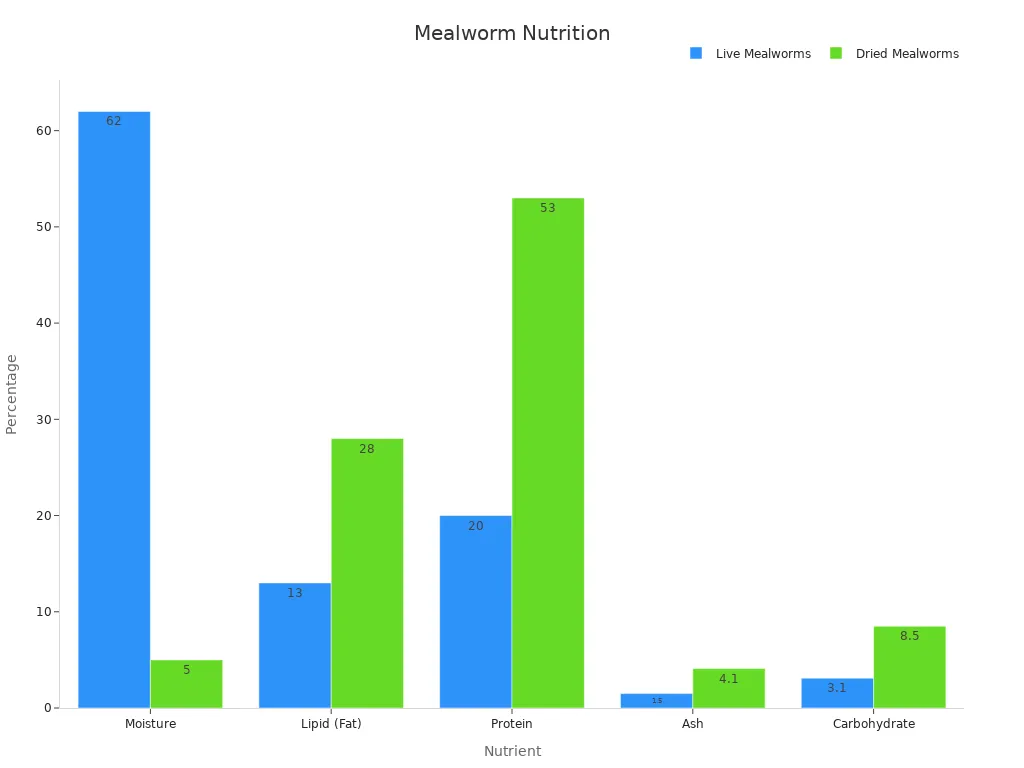
Dried mealworms, with their higher protein and fat content, are especially beneficial during breeding seasons or harsh winters. They provide the energy birds need to thrive, regardless of the time of year.
While mealworms are a fantastic addition to a bird’s diet, they shouldn’t be the only food source. A variety of seeds, fruits, and insects ensures birds get all the nutrients they need.
Benefits for Nesting and Migratory Birds
Mealworms are a powerhouse of nutrition for nesting and migratory birds. Their high fat and protein content supports birds during critical life stages. For example:
- Young birds need protein to grow strong feathers and muscles.
- Female birds preparing to lay eggs benefit from the extra energy mealworms provide.
- Migratory birds rely on fat reserves for long flights, making mealworms an ideal food source.
A study in Sweden highlighted the impact of mealworms on nesting birds. Female northern wheatears fed with mealworms weighed significantly more than those without access to this food. The average weight of fed females was 26.9 grams, compared to 24.4 grams for unfed males. Additionally, mealworms were primarily delivered to chicks shortly after hatching, emphasizing their importance during early growth stages.
By offering bird feed mealworms, feeders can support birds through nesting, migration, and beyond. These little treats make a big difference in the lives of our feathered friends.
How to Use Bird Feed Mealworms Effectively
Presentation Methods: Feeders, Ground, or Mixing with Seeds
Bird feed mealworms can be offered in several ways to attract a variety of birds. Using feeders is one of the most effective methods. Birds like bluebirds and chickadees prefer hanging feeders with shallow trays or mesh designs that hold mealworms securely. For ground-feeding birds like robins, sprinkling mealworms directly on the ground works wonders. Mixing mealworms with seeds in a feeder creates a balanced snack that appeals to a broader range of species.
Studies have shown that presentation methods can impact feeding efficiency. For instance, a study on Japanese quails revealed that diets supplemented with mealworm scales improved feed conversion ratios (FCR). The group with the highest supplementation (3g/kg) achieved the best FCR of 2.75, compared to 3.17 in the control group.
| Group | Overall Feed Conversion Ratio (FCR) |
|---|---|
| G1 (Control) | 3.17 |
| G2 (1g/kg mealworm scales) | 2.90 |
| G3 (2g/kg mealworm scales) | 2.83 |
| G4 (3g/kg mealworm scales) | 2.75 |
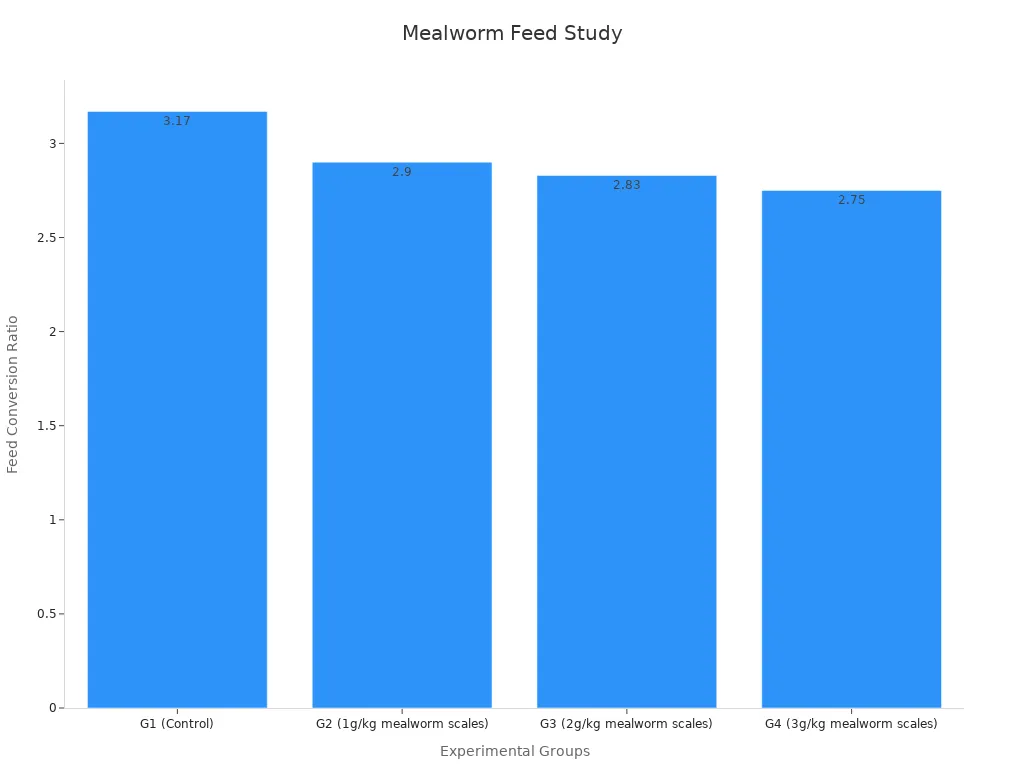
Portion Sizes for Different Bird Species
Portion sizes depend on the bird species and their nutritional needs. Bluebirds, for example, thrive on about 15 mealworms per day. This amount provides enough protein without overfeeding. Offering mealworms as an occasional treat or during harsh weather ensures birds get the energy they need without becoming dependent.
| Bird Species | Recommended Portion Size | Notes |
|---|---|---|
| Bluebirds | 15 mealworms/day | Offer as an occasional treat or during bad weather. Limit to 15 per bird. |
Storage Tips to Maintain Freshness and Quality
Proper storage keeps mealworms fresh and nutritious. Dried mealworms should be stored in airtight containers in a cool, dry place to prevent moisture and mold. Live mealworms require ventilated containers with bedding like bran or oats. Storing them in a cool area, such as a refrigerator, slows their metabolism and extends their shelf life. Adding small amounts of vegetables like carrots or potatoes provides hydration and keeps them healthy.
Tip: Always reseal dried mealworm packages after use to maintain their quality for year-round feeding.
Why Bird Feed Mealworms Are Better Than Other Options
Comparison to Seeds and Nuts
Bird feed mealworms stand out when compared to seeds and nuts. While seeds and nuts are common bird feed options, they don’t always provide the same level of nutrition. A study on Cape White-eyes revealed that birds fed mealworms maintained or even gained body mass. In contrast, those on a fruit-based diet lost weight. This shows that mealworms offer better energy and nutrient absorption.
Seeds and nuts may lack the high protein content that birds need for growth and energy. Mealworms, on the other hand, are packed with protein and fats, making them a more balanced choice. They also mimic the insects birds naturally eat, which makes them more appealing.
Advantages Over Suet and Other Protein Sources
Mealworms also have several advantages over suet and other protein sources. For one, dried mealworms are easy to store. They don’t require refrigeration, which reduces hassle and cost. Handling them is also less messy compared to live mealworms or suet.
- Dried mealworms have a long shelf life, so they stay fresh for months.
- They are lightweight and easy to transport.
- Birds find them highly appealing, especially during nesting and migration seasons.
Live mealworms, while slightly more challenging to store, provide moisture that’s beneficial for hydration. This makes them especially useful for feeding baby birds. Whether dried or live, mealworms are a convenient and nutritious option for bird enthusiasts.
Long Shelf Life and Year-Round Usability
One of the biggest advantages of mealworms is their long shelf life. Dried mealworms can be stored for months without losing their nutritional value. They don’t spoil easily, even in warmer climates, making them ideal for year-round feeding.
Bird feed mealworms are also versatile. They can be used alone in feeders, sprinkled on the ground, or mixed with seeds. This flexibility allows bird lovers to cater to different species and feeding habits. With their extended shelf life and usability, mealworms are a reliable choice for supporting birds throughout the year.
Dried mealworms are a game-changer for bird enthusiasts. They’re nutritious, easy to use, and loved by countless bird species. Offering bird feed mealworms ensures birds stay healthy and energized throughout the year. Why wait? Add them to your feeder today and enjoy the lively chirps of happy visitors in your backyard!
FAQ
What’s the best way to store dried mealworms?
Keep dried mealworms in a resealable container in a cool, dry place. This prevents moisture and keeps them fresh for year-round feeding.
Can mealworms be fed to other animals besides birds?
Mealworms are great for reptiles, chickens, fish, and even monkeys. Their high protein content makes them a versatile feed option.
How do you rehydrate dried mealworms?
Soak dried mealworms in warm water for 10–15 minutes. This softens them and adds moisture, making them easier for birds to eat.


